
サハリン/樺太アイヌの政治的位置
Sakhalin Ainu in present Japan

☆ 北海道アイヌ協会は、戸籍をもってアイヌ民族と証明するという、世界の先住民のトレンドからみれば逆行する、(政府と共に)アイヌ民族の自己決定権の無力 化に加担している可能性があります。ロシアでのアイヌ民族の取り扱い(後述)では、アイヌ民族の存在をそもそも認めていないという「統計的ジェノサイド」 に近い状況にあります。
「な ぜ日本の先住民族アイヌがそこ(→国や憲法)に入っていないのですか。やっぱりアイヌは日本という国の中で存在しないということと同じになっているわけで すね。それは樺太アイヌにとってみれば、はっきりわかる。私が戸籍を取っても、樺太アイヌ民族だと証明できるものは何も出てきません。「外務省に問い合わ せてください」と言われました。樺太アイヌと証明できるのは、わずか6人しかいません。北海道アイヌ協会は(会員資格として)「戸籍をもってアイヌ民族だ と証明する」と言い張っています。そうでない人は、文化を継承している隣近所の人から「あそこはアイヌだよ」という、そういう証明がなければ行政的には一 切アイヌだと証明されません」(田澤守 氏の2017年6月18日の発言)
で は、サハリンアイヌとは誰のことか?——それは自分の「サハリンアイヌ/樺太アイヌ」としての出自をたどり、自らがその末裔であると主張するすべての人の ことである。ここでいう「自分の出自」とは、戸籍による証明ではなく、自分の祖先から伝承や写真や「家族において伝えられてきたこと」全般であり、仮に断 片的なものであっても、かまわないのです。そのような歴史的存在としての認識と、アイヌとしてのア イデンティティにおいて、あらゆる先住民性は担保することができます(→「先住民 とは誰か?」)。
ウィ
キペディア(日本語)の「樺太アイヌ」から、支配民族である和人(シサム、シャモ)がどのように、樺太アイヌを描いてきたのかをまず、把握してみましょ
う。
| 樺太アイヌ(からふとアイヌ、アイヌ語: repunmosir-un-kuru)ある
いはサハリンアイヌ(英語: Sakhalin
Ainu)とは、かつて樺太南部に居住していたアイヌ系民族である。樺太アイヌ語ではエンチウと呼ばれる[1]。 北海道アイヌや千島アイヌとは異なる文化・伝統を有することで知られる。トンコリ(五弦の琴)やミイラ葬の風習は、アイヌ文化の中でも樺太アイヌにしか伝 承されていない。1945年のソ連による樺太占領によって大多数の樺太アイヌは樺太を離れ、以後は北海道各所に散在している。 |
|
| 「樺太アイヌ」または「サハリンアイヌ」の名前で知られているものの、
実際には樺太全域に居住していたわけではなく、特に樺太南部に集中して居住していた。これは樺太アイヌの祖先が先住民(オホーツク文化人=ニヴフ)を押し
のける形で北海道から樺太へ進出していった歴史が関係していると考えられる。13世紀から近代に至るまで、樺太では樺太アイヌ、ウィルタ(アイヌからの呼
称はオロッコ)、ニヴフ(アイヌからの呼称はスメレンクル)の3民族が共存していた。 また、樺太アイヌは前近代には北海道日本海沿海部にも居住していた形跡がある。河野広道の調査によると近代においても樺太アイヌと余市アイヌは墓標の形が 同じであり、これは両者が同一の文化圏に属するグループに属することを示唆する。17世紀、シャクシャインの時代には余市・天塩・利尻・宗谷にかけてハチ ロウエモンらに率いられるアイヌ民族グループ(研究者はこれを「余市アイヌ」と呼称する)が存在したが、これも樺太アイヌに連なる集団ではないかと考えら れている。 また、北海道アイヌによる樺太アイヌ認識について、蝦夷通辞の上原熊次郎は以下のような記述を残している。 |
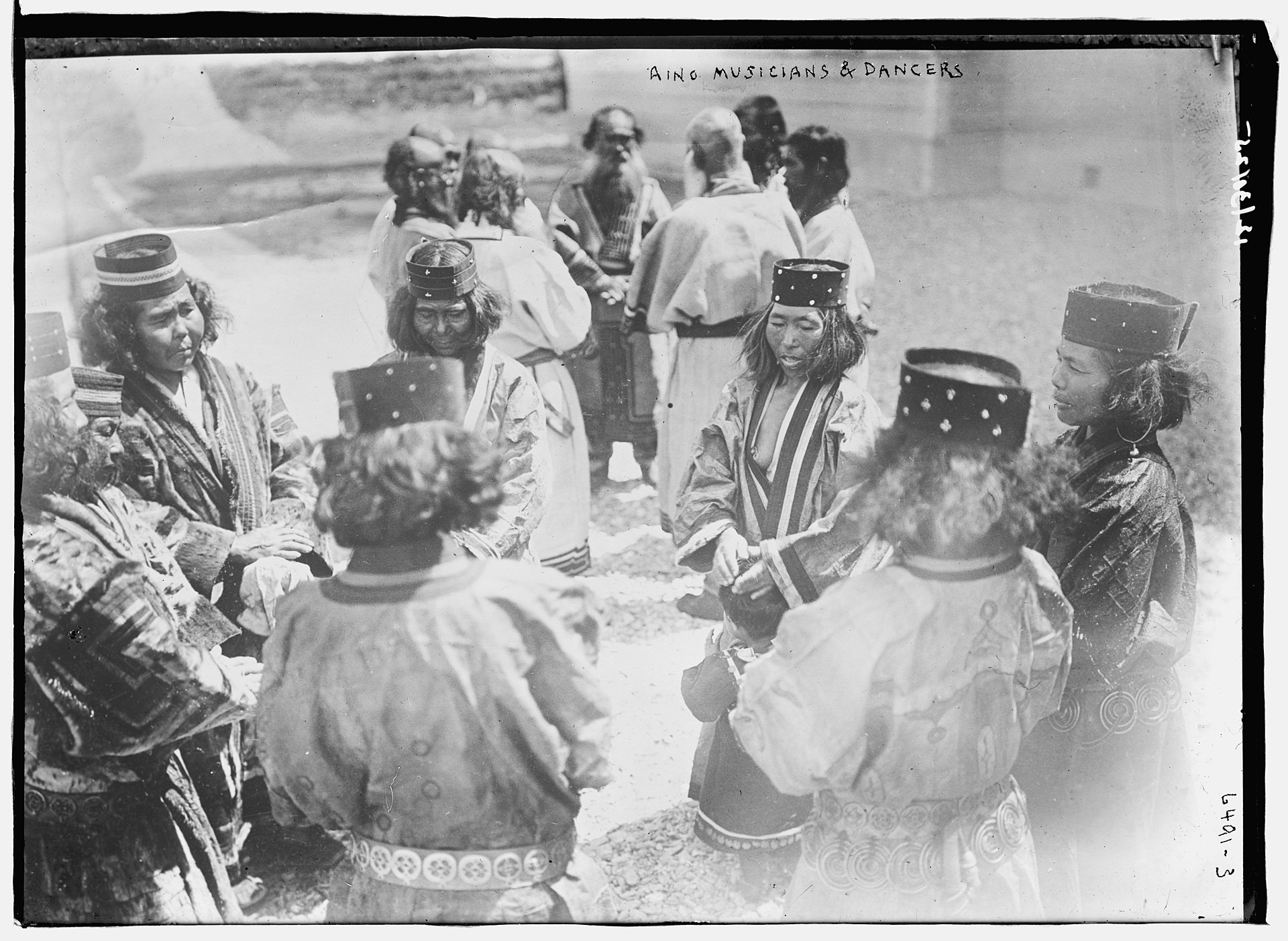 歌い踊る樺太アイヌ女性。布をリング状に巻いた頭飾りはヘトムイェと呼ばれ、樺太アイヌ特有のものである。1900年ころ撮影 |
| 扠又、当所(静内)よりポロイヅミ(襟裳)辺までの蝦夷をまとめてメナ
シウンクルといふ。則、東のものといふ事。……北蝦夷地(樺太)、其外嶋々の夷人をレブンモシリウンクルといふ。則、離島のものといふ事なり……。 — 上原熊次郎『蝦夷地名考并里程記』 |
|
| この記述によると、北海道アイヌは樺太を中心として周辺の島々(礼文
島・利尻島)に居住する者達を「レブンモシリウンクル(アイヌ語:
repunmosir-un-kuru)」と呼ばれる一つのグループとして認識していたという。 |
|
| 近代以前 アイヌ文化が成立する13世紀以前、樺太・北海道東北部・千島にはオホーツク文化人が居住しており、日本からは粛慎(ミシハセ)、中国からは流鬼と呼称さ れていた。 13世紀モンゴル帝国(後、大元ウルス)が勃興すると、アムール川河口付近に居住する「吉里迷」(ギレミ、オホーツク文化人に相当すると見られる)を従え るようになった。1264年にはギレミの民が「骨嵬(クイ)」や「亦里于(イリウ)」が攻めてくるとセチェン・カーン(世祖クビライ)に訴えたため、モン ゴルは軍勢を樺太に派遣し、骨嵬(=アイヌ)を討伐した。この頃、北海道から樺太に進出したアイヌ系集団が樺太アイヌの祖先になったと考えられている。 江戸時代、樺太アイヌはアムール川流域の諸民族と交易を行い(山丹交易)、樺太アイヌがもたらす蝦夷錦などの物品はアイヌ社会・和人社会双方で珍重され た。 19世紀以降  樺太アイヌの住居(1912年、鳥居龍蔵撮影) 人物は左から木村チカマ、坪沢テル、影山チウカランケ、坪沢六助 1875年(明治8年)、日露間で千島・樺太交換条約が結ばれ、樺太アイヌと千島アイヌは3年の経過措置の後に居住地の国民とされることになった[2]。 開拓使の長官黒田清隆は樺太アイヌを北海道に集団移住させることを決め、判官の松本十郎を現地に派遣した[2]。一応は移住希望者の募集が行われたもの の、アイヌ側の反発は強く、「故郷の島影が見える宗谷ならば」という形で妥協したというのが実態のようである[2]。当時の南樺太に在住していた先住民族 は、アイヌを主体に2372人だったが、そのうち108戸841人の樺太アイヌが宗谷へと移住した[2]。 ところが翌1876年(明治9年)、黒田は樺太アイヌを対雁(石狩川下流、旧豊平川との合流点付近)に再移住させるよう部下に命じた[3]。「宗谷なら ば」という条件でアイヌ内部を取りまとめていた首長は突然の裏切りに憤死し、残った人々は銃で脅されながら強制移住させられたという[3]。後からこの顛 末を聞き知った松本は激怒し、開拓使の職を辞して二度と戻らなかった[3]。 対雁の樺太アイヌは政府から農業指導を受けたが、もともと漁業で生活していただけに収穫は芳しくなく、開拓使の保護政策も成果を挙げられなかった[4]。 男たちはあくまで漁業で生きるため、春には厚田のニシン漁、秋には石狩のサケ漁へと出稼ぎをするようになった[4]。 1879年(明治12年)、日本全国でコレラが発生。対雁の樺太アイヌのうち74名が感染し、30名が死亡した[4]。1882年(明治15年)、保護政 策が打ち切りとなったため、アイヌたちは「対雁移民組合」を設立する[5]。1886年(明治19年)から1887年(明治20年)にかけて、またもコレ ラと天然痘が大流行。対雁のアイヌのうち300名が犠牲となった[6]。生存者たちの多くは石狩の来札へと移住し、組合事務所も移転したが[6]、 1892年(明治25年)から3年間も不漁が続き、資金の損失により組合の事業を縮小せざるを得なくなった[7]。 ポーツマス条約によって南樺太が日本領となった翌年の1906年(明治39年)8月、樺太アイヌの大多数は故郷へと帰還することとなった[8]。内訳は帰 島する者339名、北海道に残る者12名、行方不明者15名で、その人口は実に半数以下に減少していた[8]。 1945年(昭和20年)にはソビエト連邦によって南樺太は占領され、これに伴い多くの樺太アイヌが北海道へと移住した。南樺太に留まった樺太アイヌのそ の後についてはロシアにおけるアイヌを参照。 |
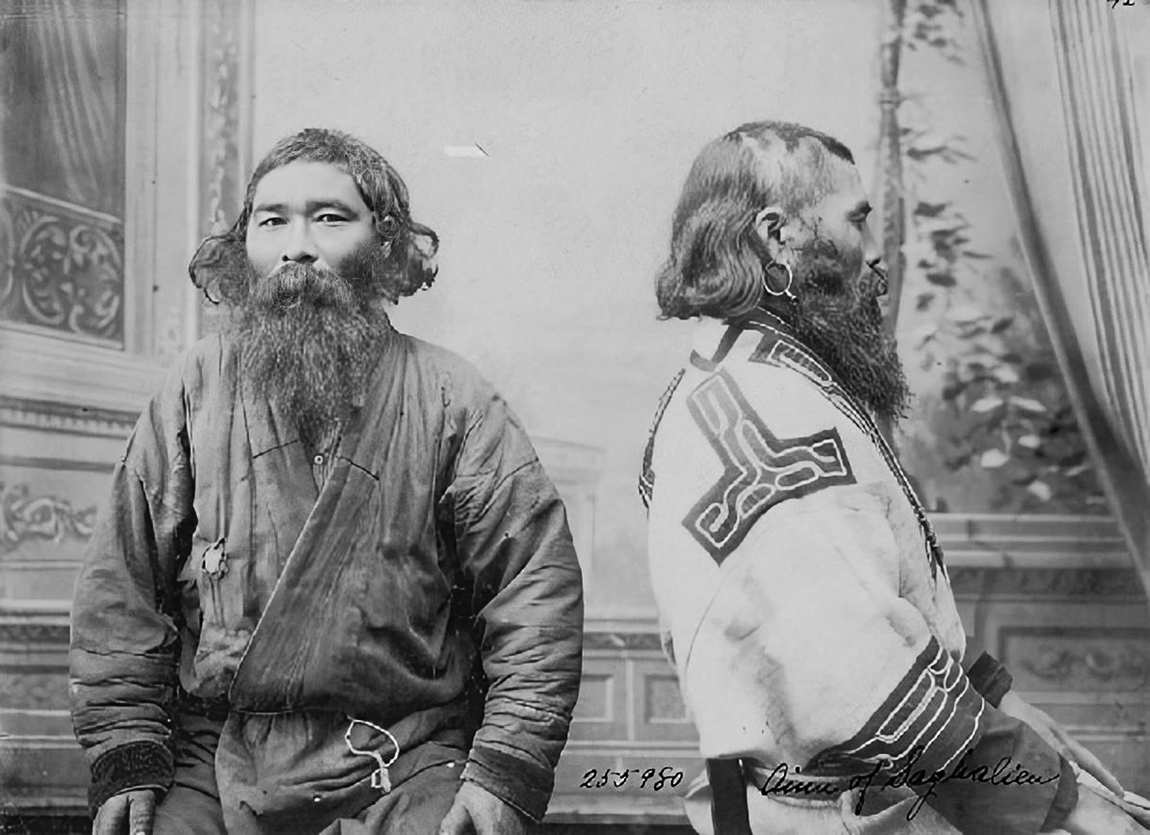 2人のアイヌの男性(サハリン、樺太から)。ブロニスワフ。ピウスツキが撮影した。 |
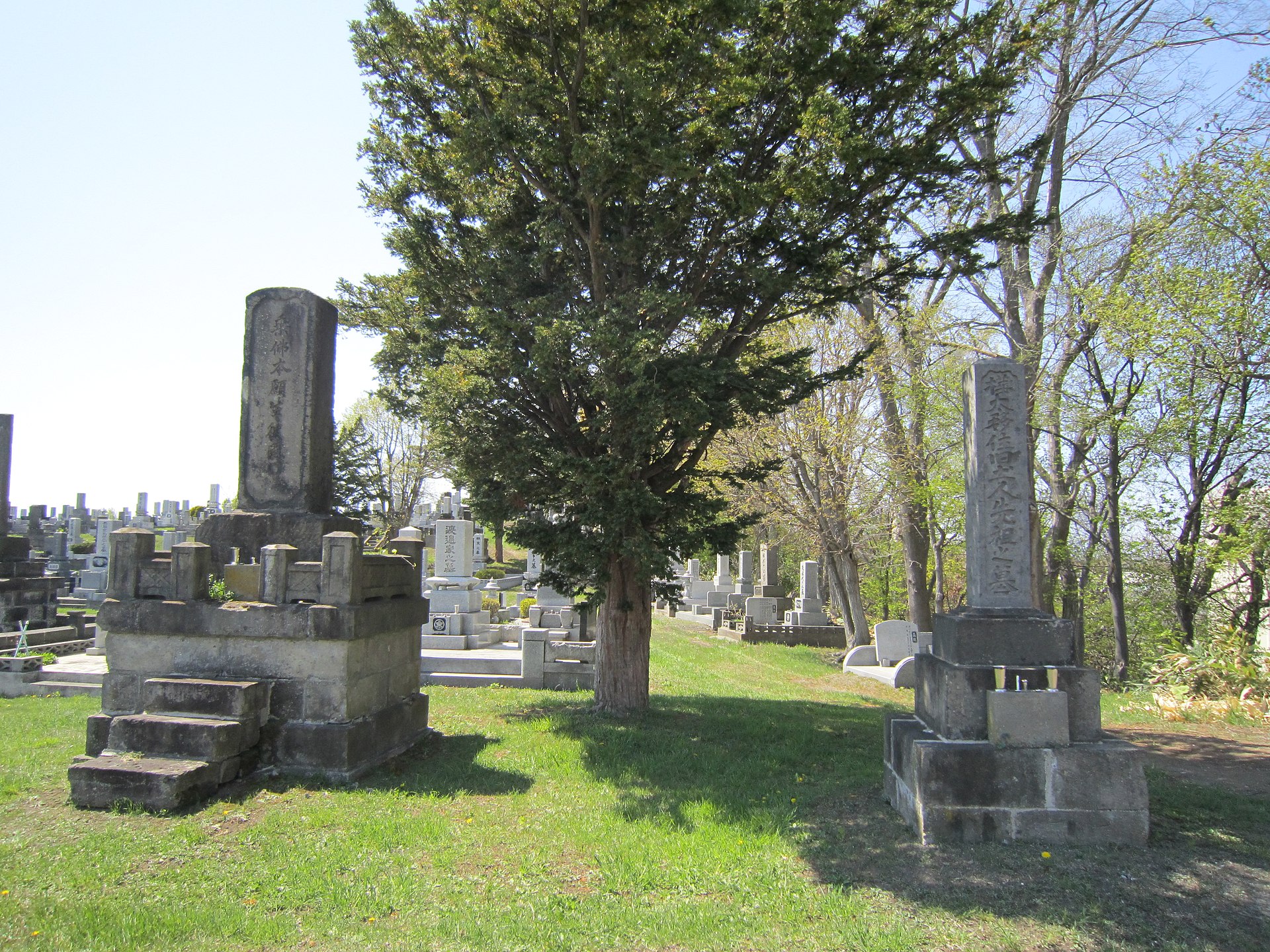 江別市対雁の樺太アイヌ慰霊碑 |
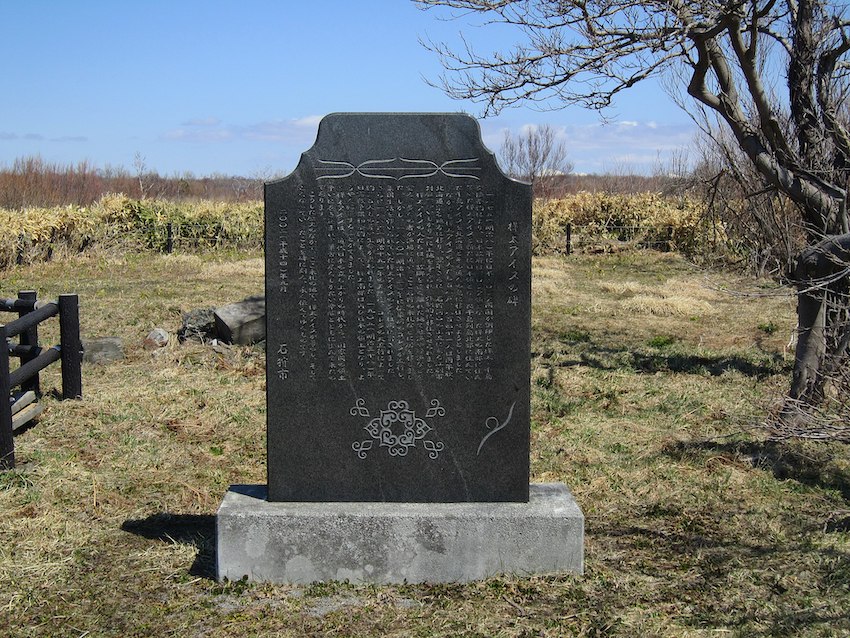 石狩市八幡墓地の樺太アイヌの碑 |
| 文化 音楽 樺太アイヌ独自の楽器として、トンコリという弦楽器がよく知られている。現在では樺太アイヌのみならず、北海道アイヌや和人の間でもトンコリを用いた演奏 がなされるようになっている。 住居  青森県の三内丸山遺跡に復元された、縄文時代の土葺き竪穴建物。樺太アイヌの竪穴建物は、これに煙突をつけた形式である(これは推定)。 樺太アイヌは他のアイヌ民族グループと異なり、夏期用の家「サㇵチセ(sahcise=夏の家)」と冬期用の家「トイチセ(toycise=土の家)」を 持つことで知られる。 冬期用のトイチセとは竪穴建物のことで、松田伝十郎の『北夷談』や間宮林蔵の『北蝦夷図説』などにも記載がある。屋内には囲炉裏と共にカマドがあり、樹皮 で葺いた上に土を盛った屋根には煙突がつき出している。だがトイチセの居住環境は通気などの関係で劣悪なため時代を経る毎に使われなくなってゆき、20世 紀にはより寒冷な北部の集落でしか用いられなくなっていた[9]。 夏期用のサㇵチセは樹皮、特にエゾマツ (sunku) を用いて屋根を葺いていた[10]。 衣服 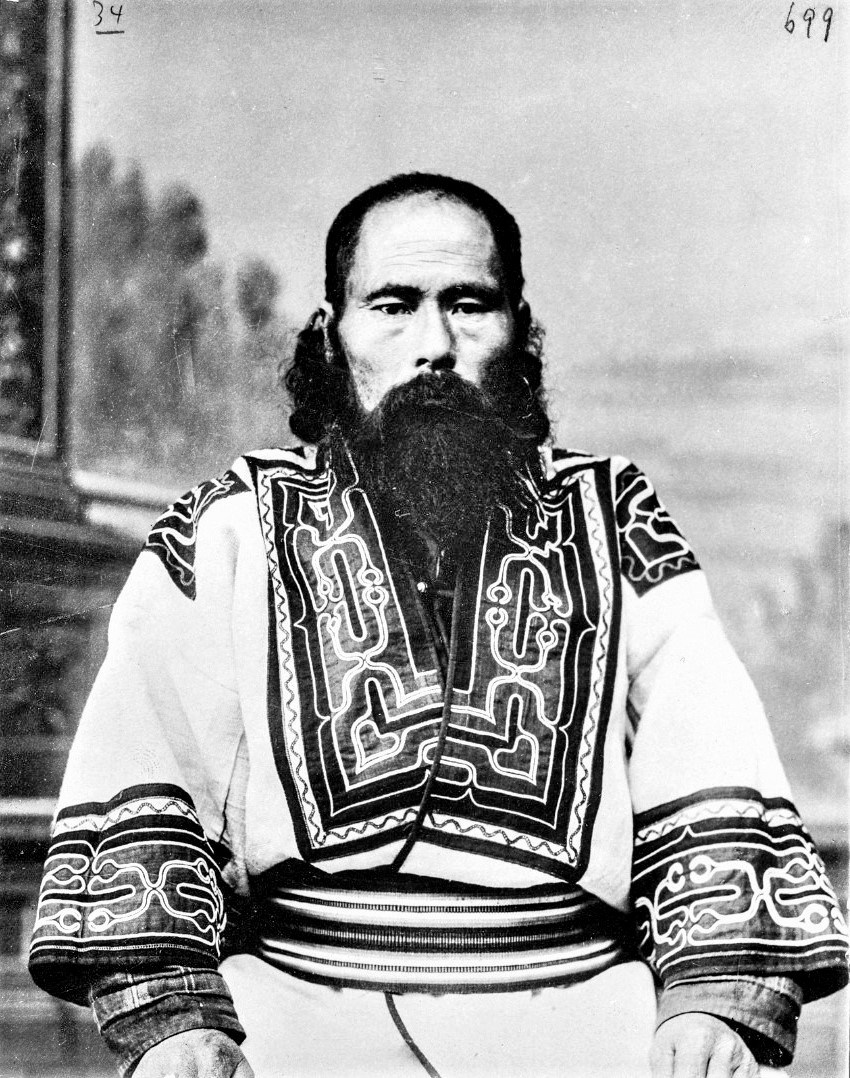 樺太東海岸のアイ集落の長・バフンケ(日本語名・木村愛吉 1855〜1919?)。衣服のアイヌ文様は、北海道アイヌとは微妙な違いがある 樺太の気候は北海道に比べ寒冷なため、衣服の材料はイラクサの繊維か、獣皮を鞣したものを用いていた。最も多く用いられたのはトナカイ(アイヌ語: tunakay)やジャコウジカ(アイヌ語:opokay)の皮で、ほかにイトウやアメマスなどの魚皮を用いることもあった。ただし熊と山猫の皮は決して 使われることがなく、またアザラシ(アイヌ語:tukari)の皮で作った着物は「神衣(アイヌ語:kamuy-rus)」と呼ばれた。 晴れ着はsiwh-imi/siyuh-imiと呼ばれ、肩に文様を入れるのが常であった。樺太アイヌの間でtah-ru-kor-imi(肩に文様を持 つ着物)と言えば晴れ着か、日常着でも上等のものを指していた[11]。 言語 詳細は「樺太アイヌ語」を参照 樺太アイヌ語は千島アイヌ語同様に現在母語とする話者が存在しないが、千島アイヌ語に比べると比較的言語資料が多く残っているため、樺太アイヌ語の教科書 が作られるなどの動きが存在する。 |
|
| The Ainu in Russia are an
indigenous people of Siberia located in Sakhalin Oblast, Khabarovsk
Krai and Kamchatka Krai. The Russian Ainu people (Aine; Russian: айны,
romanized: Ayny), also called Kurile (курилы, kurily), Kamchatka's
Kurile (камчатские курилы, kamchatskiye kurily / камчадальские айны,
kamchadalskiye ayny) or Eine (эйны, eyny), can be subdivided into six
groups. Although only around 100 people currently identify themselves as Ainu in Russia (according to the census of 2010), it is believed that at least 1,000 people are of significant Ainu ancestry. The low numbers identifying as Ainu are a result of the refusal by the government of the Russian Federation to recognise the Ainu as a "living" ethnic group. Most of the people who identify themselves as Ainu live in Kamchatka Krai, although the largest number of people who are of Ainu ancestry (without acknowledging it) are found in Sakhalin Oblast. Many local people are ethnically Ainu or have significant Ainu ancestry but identify as Russian or Nivkh and speak Russian as mother tongue, often not knowing about their Ainu ancestry.[3] |
ロシアのアイヌ民族は、サハリン州、ハバロフスク・クライ、カムチャッ
カ・クライに位置するシベリアの先住民族である。ロシアのアイヌ民族(アイヌ語; ロシア語: айны, ローマ字表記: アイヌ(ロシア語:
айны、ローマ字表記: Ayny)は、クリル(курилы, kurily)、カムチャッカのクリル(камчатские курилы,
kamchatskiye kurily / камчадальские айны, kamchadalskiye
ayny)、アイヌ(эйны, eyny)とも呼ばれ、6つのグループに分けられる。 現在ロシアでアイヌと名乗る人は約100人(2010年の国勢調査による)しかいないが、少なくとも1,000人はアイヌの祖先を持つと考えられている。 アイヌと名乗る人の数が少ないのは、ロシア連邦政府がアイヌを「生きている」民族集団として認めない結果である。アイヌであると自認する人々のほとんどは カムチャツカ・クライに住んでいるが、アイヌの先祖を(アイヌであると認めずに)持つ人々が最も多いのはサハリン州である。現地の多くの人々は民族的には アイヌであるか、アイヌの祖先を持つが、ロシア人またはニブフ人であると自認し、ロシア語を母語として話す。 |
| Ainu trading expeditions with
the Kamchatka Peninsula and other northern regions which today are part
of Russia began very early on, despite the traditionally sedentary
customs of Ainu society. Ainu migrations to Kamchatka and the Amur
River area from Hokkaido were increasingly limited after the 16th
century however, as Japanese merchants and officials increasingly
limited their ability to migrate.[4] The Kamchatka Ainu first came into contact with Russian fur traders by the end of the 17th century. Contact with the Amur Ainu and North Kuril Ainu were established during the 18th century. By mid-18th century more than 1,500 Ainu had accepted Russian citizenship.[citation needed] The Ainu (especially those in the Kuriles) supported the Russians over the Japanese in conflicts of the 19th century. However, after their defeat during the Russo-Japanese War of 1905, the Russians abandoned their allies and left them to their fate. Hundreds of Ainu were executed and their families were forcibly relocated to Hokkaido by the Japanese. As a result, the Russians failed to win over the Ainu during World War II.[citation needed] Resettlement in Kamchatka As a result of the Treaty of St. Petersburg, the Kurile islands were surrendered to the Japanese, along with the Ainu inhabitants. A total of 83 North Kurile Ainu arrived in Petropavlovsk-Kamchatsky on September 18, 1877, after they decided to remain under Russian rule. They refused the offer by Russian officials to move to new reservations in the Commander Islands. An agreement was reached in 1881 and the Ainu chose to settle in the village of Yavin. In March 1881, the group left Petropavlovsk and began the long journey to Yavin by foot. Four months later, they reached their new homes. Another village, Golygino, was founded later. Nine more Ainu arrived from Japan in 1884. According to the 1897 Census of Russia, Golygino had a population of 57 (all Ainu) and Yavin a population of 39 (33 Ainu & 6 Russian).[5] However, under Soviet rule both villages were abolished and inhabitants forcibly moved to the ethnic Russian-dominated Zaporozhye settlement in Ust-Bolsheretsky Raion.[6] As a result of intermarriage, the ethnic groups assimilated to form the Kamchadal community. During the Tsarist period, the Ainu living in Russia were forbidden to identify themselves by that name, since the Japanese officials claimed that all areas inhabited by the Ainu in the past or present belonged to Japan. The Ainu were referred to as "Kurile", "Kamchatka Kurile" or simply as Russian. As a result, many Ainu changed their surnames to Slavic sounding ones.[citation needed] On 7 February 1953, K. Omelchenko, the Soviet Minister of the Protection of Military and State Secrets banned the press from publishing any information on the Ainu still living in the USSR. The order was finally revoked after two decades.[7] Recent History The North Kurile Ainu of Zaporozhye are the largest Ainu subgroup remaining in Russia. The Nakamura clan (South Kuril Ainu on the paternal side) are the smallest and number just 6 individuals who live in Petropavlovsk. There are several dozen people on Sakhalin Island who identify themselves as Sakhalin Ainu, but many more have unacknowledged partial Ainu ancestry. Most of the 888 Japanese who live in Russian territory (2010 Census) are of mixed Japanese and Ainu ancestry, though they generally do not claim it, since full Japanese ancestry gives them the right of visa-free entry to Japan.[8] Similarly, no one identifies as Amur Valley Ainu, even though people with partial descent are known to exist in Khabarovsk. It is thought that no living descendants of the Kamchatka Ainu remain today.[citation needed] In 1979, the USSR removed the term "Ainu" from the list of living ethnic groups of Russia, the government proclaiming that the Ainu as an ethnic group was now extinct in its territory. According to the 2002 Russian Federation census, no one marked the Ainu option in boxes 7 or 9.2 in the K-1 form.[9][10] The Ainu emphasize that they are the original inhabitants of the Kurile islands and that both the Japanese and Russians were invaders.[11] In 2004, the small Ainu community living in Kamchatka Krai wrote to Vladimir Putin, urging him to reconsider any move to return the Southern Kurile islands to Japan. They criticized the Japanese, the Tsarist Russians, and the Soviets for crimes against the Ainu, including killings and forced assimilation. They urged him to recognize the Japanese genocide against the Ainu people, which Putin refused to do.[12] During the 2010 Census of Russia, almost 100 people tried to register themselves as ethnic Ainu, but the governing council of Kamchatka Krai refused to do so and enrolled them as ethnic Kamchadal.[13][14] In 2011, the leader of the Ainu community in Kamchatka, Alexei Vladimirovich Nakamura requested that Vladimir Ilyukhin (Governor of Kamchatka) and Boris Nevzorov (Chairman of state Duma) include the Ainu in the central list of Indigenous small-numbered peoples of the North, Siberia and the Far East. This was also turned down.[15] Ethnic Ainu living in Sakhalin Oblast and Khabarovsk Krai are not politically organized. According to Alexei Nakamura, as of 2012, there were only 205 Ainu living in Russia (up from just 12 people who self-identified as Ainu in 2008) and they, with the Kurile Kamchadals (Itelmen of Kuril Islands), are fighting for official recognition.[16][17] Since the Ainu are not recognized in the official list of ethnic groups living in Russia, they are either counted as people without nationality or as ethnic Russian, Nivkh or Kamchadal.[18] As of 2012, both the Kurile Ainu and Kurile Kamchadal ethnic groups do not have the fishing and hunting rights the Russian government grants to other indigenous tribal communities of the far north.[3][19] The Ainu have now formed a Russian Association of the Far-Eastern Ainu (RADA) under Rechkabo Kakukhoningen (Boris Yaravoy).[20] In March 2017, Alexei Nakamura revealed that plans for an Ainu village to be created in Petropavlovsk-Kamchatsky, and plans for an Ainu dictionary are underway.[21] |
アイヌ社会の伝統的な定住習慣にもかかわらず、カムチャッカ半島や今日
ロシアの一部となっている他の北方地域とのアイヌ交易遠征は非常に早い時期から始まっていた。北海道からカムチャッカやアムール川流域へのアイヌの移住
は、16世紀以降、日本の商人や役人が移住を制限するようになったため、ますます制限されるようになった[4]。 カムチャッカアイヌがロシアの毛皮商人と初めて接触したのは17世紀末であった。18世紀にはアムールアイヌや北クリルアイヌとの交流が始まった。18世 紀半ばには1,500人以上のアイヌがロシアの市民権を受け入れていた[要出典]。 アイヌ(特に千島列島のアイヌ)は19世紀の紛争では日本人よりもロシア人を支持した。しかし、1905年の日露戦争での敗北後、ロシアは同盟国を見捨 て、彼らの運命に委ねた。何百人ものアイヌが処刑され、その家族は日本軍によって北海道に強制移住させられた。その結果、ロシアは第二次世界大戦中にアイ ヌに勝利することができなかった[要出典]。 カムチャッカ移住 サンクトペテルブルク条約の結果、千島列島はアイヌの住民とともに日本に降伏した。1877年9月18日、北千島のアイヌ83人がロシアの支配下に留まる ことを決意し、ペトロパブロフスク・カムチャツキーに到着した。彼らは、コマンダー諸島の新しい居留地に移るというロシア当局の申し出を拒否した。 1881年に合意に達し、アイヌはヤヴィン村に定住することを選んだ。1881年3月、一行はペトロパブロフスクを出発し、徒歩でヤヴィンまでの長い旅を 始めた。4ヵ月後、彼らは新しい家にたどり着いた。その後、もうひとつの村、ゴリギノが設立された。1884年にはさらに9人のアイヌが日本から到着し た。1897年のロシアの国勢調査によると、ゴリギノの人口は57人(全員アイヌ人)、ヤヴィンの人口は39人(アイヌ人33人、ロシア人6人)であった [5]。しかし、ソビエトの支配下で両村は廃止され、住民はウスチ=ボルシェレツキーライオンにあるロシア系民族が支配するザポロジエ集落に強制移住させ られた[6]。 ツァーリスト時代、ロシアに住むアイヌはその名で名乗ることを禁じられていた。日本の官憲は、過去も現在もアイヌが居住する地域はすべて日本に属すると主 張していたからである。アイヌは「クリル」、「カムチャッカ・クリル」、あるいは単にロシア人と呼ばれた。その結果、多くのアイヌがスラブ系の名字に改名 した[要出典]。 1953年2月7日、ソ連の軍事・国家機密保護大臣K.オメルチェンコは、ソ連に居住するアイヌに関するいかなる情報も報道機関に掲載することを禁止し た。この命令は20年後にようやく取り消された[7]。 近年の歴史 ザポロジエの北クリルアイヌは、ロシアに残る最大のアイヌのサブグループである。中村氏(父方は南クリルアイヌ)は最小で、ペトロパブロフスクに住むわず か6人である。サハリン島には自らをサハリンアイヌと名乗る人が数十人いるが、それ以外にもアイヌの祖先を部分的に持つ無自覚な人が多い。ロシア領内に住 む日本人888人(2010年国勢調査)のほとんどは、日本人とアイヌの混血であるが、完全な日本人の先祖を持つことで日本へのビザなし入国が認められて いるため、一般的にアイヌの先祖を名乗ることはない[8]。同様に、ハバロフスクには部分的な先祖を持つ人々が存在することが知られているが、アムール渓 谷アイヌを名乗る人はいない。カムチャッカ・アイヌの生きた子孫は現在も残っていないと考えられている[要出典]。 1979年、ソビエト連邦はロシアの現存民族リストから「アイヌ」という用語を削除し、政府は民族としてのアイヌは領土内で絶滅したと宣言した。2002 年のロシア連邦の国勢調査によると、K-1用紙の7欄と9.2欄にアイヌの選択肢を記入した者はいなかった[9][10]。 アイヌは自分たちが千島列島の原住民であり、日本人とロシア人はどちらも侵略者であると強調している[11]。 2004年、カムチャツカ・クライに住む小さなアイヌのコミュニティはウラジーミル・プーチンに手紙を送り、南クリル諸島を日本に返還する動きを再考する よう求めた。彼らは、日本人、ツァーリズム時代のロシア人、そしてソビエトがアイヌに対する犯罪(殺害や同化の強制など)を犯したと批判した。2010年 のロシア国勢調査では、100人近くがアイヌ民族として登録しようとしたが、カムチャツカ・クライの統治評議会はこれを拒否し、カムチャダル民族として登 録した[13][14]。 [13][14]2011年、カムチャッカのアイヌコミュニティのリーダーであるアレクセイ・ウラジミロヴィチ・ナカムラは、ウラジーミル・イリューヒン (カムチャッカ州知事)とボリス・ネヴゾロフ(州議会議長)に対し、アイヌを北方、シベリア、極東の先住民族少数民族の中央リストに含めるよう要請した。 これも却下された[15]。 サハリン州とハバロフスク州に住むアイヌ民族は政治的に組織化されていない。アレクセイ・ナカムラによると、2012年現在、ロシアに住むアイヌは205 人(2008年にアイヌであると自認していたのはわずか12人だった)しかおらず、彼らはクリル・カムチャダル(千島列島のイテルメン)とともに公式な承 認を求めて戦っている[16][17]。 2012年現在、クリレ・アイヌとクリレ・カムチャダルの両民族は、ロシア政府が極北の他の先住民族コミュニティに与えている漁業権と狩猟権を持っていな い[3][19]。 アイヌは現在、レチカボ・カクホニンゲン(ボリス・ヤラヴォイ)の下でロシア極東アイヌ協会(RADA)を結成している[20]。 2017年3月、アレクセイ・ナカムラはペトロパブロフスク・カムチャツキーにアイヌ村を作る計画とアイヌ語辞典の計画が進行中であることを明らかにした [21]。 |
| Demographics According to the Russian Census (2010), a total of 109 Ainu live in Russia. Of this, 94 lived in Kamchatka Krai, 4 in Primorye, 3 in Sakhalin, 1 in Khabarovsk, 4 in Moscow, 1 in St.Petersburg, 1 in Sverdlovsk, and 1 in Rostov. The real population is believed to be much higher, as hundreds of Ainu in Sakhalin refused to identify themselves as such. Additionally many local people are ethnically Ainu or have significant Ainu ancestry, but identify as various recognized groups, such as Nivkhs and speak Russian as mother tongue, often not knowing about their Ainu ancestry.[22] Ainu of Sakhalin During the Tsarist times, the Ainu living in Russia were forbidden from identifying themselves as such, as the Imperial Japanese officials had claimed that all the regions inhabited by the Ainu in the past or present, are a part of Japan. The terms "Kurile", "Kamchatka Kurile" or simply Russian, etc. were used to identify the ethnic group. As a result, large number of Ainu changed their surnames to Slavic ones. To eradicate the Ainu identity, the Soviet authorities removed the ethnic group from the list of nationalities which can be mentioned in the passport, as they feared the Ainu as possible Japanese spies. Due to this, children born after 1945 were not able to identify themselves as Ainu. After World War II, many of the Ainu living in Sakhalin were deported to Japan. Out of the 1,159 known Ainu, only around 100 remained in Russia. Of those who remained, only the elderly were full blooded Ainu. Others were either mixed race, married to ethnic Russians or self-identified as Russian. The last of the official Ainu households disappeared in the late 1960s, when Yamanaka Kitaro committed suicide after the death of his wife. The couple was childless.[23] Ainu of Ust-Bolsheretsky Out of a total of 826 people living in the village of Zaporozhye in Ust-Bolsheretsky District, more than 100 people claimed during the 2010 Census that they are Ainu. They are former residents of the liquidated villages Yavin and Golygino. The number of people with Ainu ancestry is estimated to be many times this amount, but in general, there is reluctance from the individuals themselves and from the census takers to record the nationality as "Ainu" (although not on a scale which is seen in Sakhalin). The majority of the population in Zaporozhye refers themselves as either Kamchadal (a term used for the Ainu to refer to them without acknowledging their ethnic Ainu identity and other native groups) or Russian, rather than identifying with either of the two native ethnic groups (Ainu and Itelmen). Although identifying as Itelmen can give additional benefits (hunting and fishing rights), the residents seems to be wary about ethnic polarization and response from full-blooded Russian neighbors. Identifying as Ainu is not beneficial in any way. As an unrecognized nation, the Ainu are not eligible for either fishing or hunting quotas. Families who are the descended from Kuril Ainu include Butin (Бутины), Storozhev (Сторожевы), Ignatiev (Игнатьевы), Merlin (Мерлины), Konev (Коневы), Lukaszewski (Лукашевские), and Novograblenny (Новограбленные) among other unknown ones. Ainu of Clan Nakamura Unlike the other Ainu clans currently living in Russia, there is considerable doubt whether the Nakamura clan of Kamchatka should be identified as Northern Kurils Ainu, Southern Kurils Ainu or as Kamchatka Ainu. This is due to the fact that the clan originally immigrated to Kamchatka from Kunashir in 1789. The Ainu of Kunashir are South Kurils Ainu. They settled down near Kurile Lake, which was inhabited by the Kamchatka Ainu and North Kuril Ainu. In 1929, the Ainu of Kurile Lake fled to the island of Paramushir after an armed conflict with the Soviet authorities. At that time, Paramushir was under Japanese rule. During the Invasion of the Kuril Islands, Akira Nakamura (b. 1897) was captured by the Soviet army and his elder son Takeshi Nakamura (1925–1945) was killed in the battle. Akira's only surviving son, Keizo (b. 1927) was taken prisoner and joined the Soviet Army after his capture. After the war, Keizo went to Korsakov to work in the local harbor. In 1963, he married Tamara Pykhteeva, a member of the Sakhalin Ainu tribe. Their only child, Alexei was born in 1964. The descendants of Tamara and Alexei are found in Kamchatka and Sakhalin. The last known deportation of Ainu to Japan occurred in 1982, when Keizo Nakamura, a full blooded Southern Kurils Ainu was deported to Hokkaido after serving 15 years hard labor in the province of Magadan. His wife, Tamara Timofeevna Pykhteeva was of mixed Sakhalin Ainu and Gilyak ancestry. After the arrest of Keizo in 1967, Tamara and her son Alexei Nakamura were expelled from Kamchatka Krai and sent to the island of Sakhalin, to live in the city of Tomari. Ainu of Komandorski Islands In 1877, the Badaev (Бадаев) family split from the rest of Northern Kuril Ainu and decided to settle in the Commander Islands, along with the Aleut. They were assimilated by the Aleut and currently identify themselves as Aleut. Two of the families residing there are believed to be of partial Ainu ancestry: the Badaevs and the Kuznetsovs.[24] Commander Islands was originally designated as a refuge for the Aleut people (from Atka, Attu, Fox, Andreanof.etc.), who were forced to flee Alaska after Russia sold it to the US. In 1827, on Bering Island lived 110 people (of which 93 spoke either Aleut or Aleut-Russian creole). Since the Northern Kuril Ainu were also having similar problems, the Tsar hoped to resettle them near the Aleut. But the Ainu were skeptical of the offer and rejected it, as they wanted to stay in Kamchatka mainland, whose geography was familiar to them. Only one Ainu family moved to the island, and were joined by ethnic Russians, Kamchadals, Itelmen, Kadyaktsy (Kodiak Island Eskimo), Creoles (mixed origin people]]), Komi-Zyrians and Roma.[citation needed] By 1879, the island was home to a total of 168 Aleut and 332 Creole, plus around 50 to 60 people from other nationalities including the Ainu and Russian. All the Creole spoke the Aleut language, as it was the language of their mothers. The Ainu, along with other minorities were quickly assimilated by the Aleut within a few decades. Federal recognition According to the Census authority of Russian Federation, the Ainu are extinct as an ethnic group in Russia. Those who identify as Ainu, neither speak the Ainu language, nor practice any aspect of the traditional Ainu culture. In social behavior and customs, they are almost identical with the Old Russian settlers of Kamchatka and therefore the benefits which are given to the Itelmen cannot be given to the Ainu of Kamchatka. The Ainu language is extinct as a spoken language in Russia. The Bolsheretsky Kurile stopped using the language as early as the beginning of the 20th century. Only 3 fluent speakers remained in Sakhalin as of 1979, and the language was extinct by the 1980s there. Although Keizo Nakamura was a fluent speaker of Kurile Ainu and translated several documents from the language to Russian for the NKVD, he did not pass on the language to his son.[citation needed] (Take Asai, the last speaker of Sakhalin Ainu, died in Japan in 1994.[25]) |
人口統計 ロシアの国勢調査(2010年)によると、ロシアには合計109人のアイヌが住んでいる。その内訳は、カムチャツカ94人、沿海州4人、サハリン3人、ハ バロフスク1人、モスクワ4人、サンクトペテルブルク1人、スヴェルドロフスク1人、ロストフ1人。サハリンでは数百人のアイヌが自らをアイヌと名乗るこ とを拒否しているため、実際の人口はもっと多いと考えられている。さらに、多くの地元の人々は民族的にはアイヌであるか、アイヌの祖先を持つが、ニブフ族 などの様々な公認グループとして認識され、ロシア語を母語として話し、アイヌの祖先を知らないことが多い[22]。 サハリンのアイヌ ツァーリスト時代、ロシアに住むアイヌは、過去も現在もアイヌが居住する地域はすべて日本の一部であると主張する大日本帝国官憲によって、アイヌであるこ とを名乗ることを禁じられていた。クリル」、「カムチャッカ・クリル」、あるいは単にロシア人などと呼ばれた。その結果、多くのアイヌがスラブ系の姓に変 えた。アイヌのアイデンティティを根絶するために、ソ連当局はアイヌを日本人のスパイとして恐れ、パスポートに記載できる国籍リストからアイヌ民族を削除 した。このため、1945年以降に生まれた子どもたちは、アイヌ民族であることを名乗ることができなかった。 第二次世界大戦後、樺太に住むアイヌの多くは日本に強制送還された。1,159人のアイヌのうち、ロシアに残ったのは100人ほどだった。ロシアに残った アイヌのうち、アイヌの血を引くのは高齢者だけだった。その他は混血であったり、ロシア人と結婚していたり、ロシア人を自認していたりした。1960年代 後半、山中喜太郎が妻を亡くして自殺したことで、アイヌの公認世帯は姿を消した。夫婦には子供がいなかった[23]。 ウスチ=ボルシェレツキーのアイヌ ウスチ=ボルシェレツキー郡ザポロジェ村に住む総人口826人のうち、2010年の国勢調査で100人以上がアイヌであると主張した。彼らは、清算された ヤヴィン村とゴリギノ村の元住民である。アイヌの先祖を持つ人はこの何倍もいると推定されるが、一般的に、本人も国勢調査の調査官も「アイヌ」という国籍 の記録に消極的である(サハリンのような規模ではないが)。ザポロジエの人口の大多数は、2つの先住民族(アイヌとイテルメン)のどちらかを名乗るのでは なく、カムチャダル(アイヌ民族のアイデンティティや他の先住民族を認めずにアイヌを指す言葉)かロシア人を名乗る。イテルメンを名乗ることで、狩猟権や 漁業権などの追加的な利益を得ることができるが、住民は民族的な偏りや、血の通ったロシア系隣人からの反応を警戒しているようだ。アイヌ民族であることは 何のメリットもない。未承認国家であるアイヌは、漁業権も狩猟権も与えられない。 クリルアイヌの子孫である一族には、ブティン(Бутины)、ストロジェフ(Сторожевы)、イグナティエフ(Игнатьевы)などがいる、 Merlin(Мерлины)、Konev(Коневы)、Lukaszewski(Лукашевские)、Novograblenny (Новограбленные)などが知られている。 中村氏のアイヌ 現在ロシアに居住する他のアイヌ一族とは異なり、カムチャッカの中村一族を北クリルアイヌ、南クリルアイヌ、カムチャッカアイヌのいずれとすべきかについ てはかなりの疑問がある。これは、中村氏が1789年にクナシールからカムチャッカに移住してきたという事実に起因する。クナシルのアイヌは南クリルアイ ヌである。彼らはカムチャッカアイヌと北クリルアイヌが住んでいたクリル湖の近くに定住した。1929年、ソ連当局との武力衝突の後、クリル湖のアイヌは パラムシル島に逃れた。当時、パラムシールは日本の統治下にあった。千島列島侵攻作戦の際、中村晃(1897年生)はソ連軍に捕らえられ、長男の中村武 (1925-1945)は戦死した。アキラの一人息子、ケイゾウ(1927年生)は捕虜となり、捕虜となった後ソ連軍に加わった。戦後、敬三はコルサコフ に行き、地元の港で働いた。1963年、樺太アイヌ民族のタマラ・ピフテエワと結婚。1964年に一人息子のアレクセイが生まれた。タマラとアレクセイの 子孫はカムチャッカとサハリンにいる。 アイヌの日本への強制送還で最後に知られているのは、1982年、南クリルアイヌの血を引く中村敬三が、マガダン州で15年の重労働に服した後、北海道に 強制送還された時である。彼の妻タマラ・ティモフェーヴナ・ピクテエヴァはサハリンアイヌとギリヤーク族の混血であった。1967年に敬三が逮捕された 後、タマラと息子の中村アレクセイはカムチャツカ・クライから追放され、サハリン島の泊市に住むことになった。 コマンドルスキー諸島のアイヌ 1877年、バダエフ(Бадаев)一族は他の北クリルアイヌから分離し、アリュートとともにコマンダー諸島に定住することを決めた。 彼らはアリュートに同化され、現在はアリュートであることを自認している。 そこに居住する2つの一族は、バダエフ一族とクズネツォフ一族という部分的なアイヌの先祖を持つと考えられている[24]。 コマンダー諸島はもともと、ロシアがアラスカをアメリカに売却した後、アラスカからの脱出を余儀なくされたアリュート族(アトゥカ、アトゥ、フォックス、 アンドレアノフなど)の避難場所として指定されていた。1827年、ベーリング島には110人(うち93人はアリュート語またはアリュート・ロシア語クレ オールを話す)が住んでいた。北クリル・アイヌも同じような問題を抱えていたため、ロシア皇帝は彼らをアリュートの近くに定住させようと考えたが、アイヌ の人々はこの申し出に懐疑的で、地理的になじみのあるカムチャッカ本土に留まることを望み、これを拒否した。島に移り住んだのはアイヌの1家族だけで、ロ シア人、カムチャダル人、イテルメン人、カディアクツィ(コディアク島エスキモー)、クレオール人(混血人)、コミ・ジリア人、ロマ人などが加わった[要 出典]。 1879年までに、島には合計168人のアリュート人と332人のクレオール人、さらにアイヌ人やロシア人など他の国籍の人々が50人から60人ほど住ん でいた。クレオール人は全員アリュート語を話していた。アイヌや他の少数民族は、数十年のうちにアリュートに同化された。 連邦認定 ロシア連邦の国勢調査当局によると、アイヌはロシアでは民族として消滅している。アイヌであると自認する人々は、アイヌ語を話すこともなく、伝統的なアイ ヌ文化を実践することもない。社会的行動や習慣において、彼らはカムチャッカの旧ロシア人入植者とほとんど同じであり、したがって、イテルメンに与えられ ている利益をカムチャッカのアイヌに与えることはできない。 アイヌ語はロシアでは話し言葉としては絶滅している。ボルシェレツキー・クリールでは、20世紀の初めにはアイヌ語の使用をやめていた。サハリンでは 1979年の時点で3人しか流暢な話し手が残っておらず、1980年代には絶滅していた。中村敬三は千島アイヌ語を流暢に話し、NKVDのためにいくつか の文書をアイヌ語からロシア語に翻訳したが、息子にアイヌ語を伝えることはなかった[citation needed](樺太アイヌ語の最後の話者である浅井竹は、1994年に日本で亡くなった[25])。 |
 An Ainu flag was designed
by Bikki Sunazawa, a Japanese sculptor of Ainu ancestry.[1][2][3] An Ainu flag was designed
by Bikki Sunazawa, a Japanese sculptor of Ainu ancestry.[1][2][3]Upon a repeated request from his friend, Bikki Sunazawa eventually designed the flag in 1973 – although he distanced himself from political activism seeking government support. Nevertheless, an Ainu group displayed the flag when they marched at a May Day celebration in Sapporo in the same year.[4] On rare occasions, it is still seen at Ainu functions.[5] In 2020 Bikki's son Jin Sunazawa claimed copyright ownership and requested disuse of the flag.[6] Description The flag's ratio is most likely 2:3. The flag consists of a cerulean blue field standing for sky and sea, a white figure standing for snow, and a red arrow flying beneath Hokkaido's sky.[7] The arrow is red because of the aconite poison used in traditional hunting, a way of life that was banned by the Japanese.[5] The white figure, commonly known as Bikki mon'yō, was not a traditional Ainu motif but Bikki's personal invention.[8] |
 アイヌの旗は、アイヌの血を引く日本の彫刻家、砂澤ビッキ
によってデザインされた[1][2][3]。 アイヌの旗は、アイヌの血を引く日本の彫刻家、砂澤ビッキ
によってデザインされた[1][2][3]。砂澤ビッキは友人からの度重なる要請を受け、最終的に1973年に旗をデザインした。しかし、同年札幌で開催されたメーデーの行進の際にアイヌの団体がこ の旗を掲げた[4]。 まれに、今でもアイヌの行事でこの旗を目にすることがある[5]。 2020年、ビッキの息子である砂澤仁が著作権の所有権を主張し、旗の不使用を要請した[6]。 説明 旗の比率は2:3である可能性が高い。旗は、空と海を表すセルリアンブルーのフィールド、雪を表す白い人物、北海道の空の下を飛ぶ赤い矢で構成されている [7]。矢が赤いのは、伝統的な狩猟で使用されたトリカブトの毒に由来する。 |
| Further reading Sinelschikova, Yekaterina (27 June 2019). "Who are the Ainu and why do authorities still deny their existence?". www.rbth.com. Retrieved 15 december 2023. They are older than the Egyptians or Sumerians. Their women made tattoos resembling the Joker’s smile and their men had enormous beards. At the same time, they are one of the most persecuted people in the world. Their existence has been denied for several centuries now. Two women in traditional costumes stand opposite each other. One holds a dark eye makeup pencil, with which she is trying to draw something that looks like the famous "Joker smile" from the Batman comics on her face. "Asya, do it like this…," says one young woman to the other in Russian, using her fingers to show how it's done - from one cheek to the other. The other does as she is instructed. The black pencil leaves charcoal-like marks on the woman’s cheeks and above her mouth. "Wow, a real Ainu!" says the first woman with satisfaction. They have come to the Japanese Island of Hokkaido, which has several Ainu reservations. They are a very ancient people who once inhabited an enormous territory on the shores of the Pacific, including present-day Japan, Sakhalin Island, the Kuril Islands and the southern Kamchatka Peninsula. According to official data, only 25,000 have survived in Japan and just several dozen in Russia. In Russia, little is known about the Ainu. What is known can be enumerated on the fingers of one’s hand: The Ainu used to live in the Far East; the Ainu have been persecuted by someone throughout their long history; and, finally, the Ainu have disappeared as an ethnic group in Russia - they were deleted from the official register of ethnic groups in 1979. That is all that is commonly known about them. Still, there are Ainu in Russia. These two women, filmed by a Russian ethnographer from the Far East, look with curiosity at the huts in a reservation, something that Russia doesn't have, while shyly telling a Hokkaido Ainu that they know how to make the fold in their costume correctly. They don't need to be taught to do it. Smiling women and very hairy men The "Joker smile" is a lip tattoo, a distinctive feature of Ainu women. In the past, they would start having it "scarified" from the age of seven: Using a ceremonial knife, cuts were made in the corners of the lips, and charcoal was rubbed into the cuts. Every year several new lines would be added and the "smile" would be completed by the bridegroom at the wedding. Women also often had arm tattoos, as well. Nowadays, they no longer do it this way. Now, they only use a pencil to draw the “smile” and only on big occasions. The last Ainu woman tattooed in accordance with all the rules died in Japan in 1998. Men, on the other hand, were distinguished by an abundance of facial hair. For example, they had special sticks to support their long moustaches at mealtimes. As early as the second century BC, an ancient Chinese treatise mentioned the existence of the "hairy" people. The 18th-century Russian explorer of Kamchatka, Stepan Krasheninnikov, called the Ainu "woolly Kuril people", all because of their men. There is another curious detail: Initially, the Ainu looked more like Europeans than Asians. Krasheninnikov himself and other early Russian explorers described them as similar to Russian peasants with dark skin or to Gypsies, but not at all like the Japanese, Chinese or Mongols. The reasons must be sought in the origin of the Ainu. But in their case, one mystery gives rise to another: No-one knows where they came from. The unknown race The Ainu are believed to go back 15,000 years - further back than the Sumerians or Egyptians. For this reason, some people say the Ainu are not just a people, but a whole "Ainu race". There are two theories about their origin. The first is the "northern theory" - namely, that they came from the land in the north, later settled by the Mongols and Chinese. The second is that their ancestors are from Polynesia, because the Ainu have many similarities in dress, rituals, religion and tattoos to the inhabitants of Oceania. What is known for sure is that the Ainu were the first native people on the Islands of Japan, although the Japanese themselves have never liked this fact and have tried to hide it. The Japanese had a long-standing feud with the Ainu over territory. The natives predictably lost one battle after another, because they had never had either statehood or an army, and were pushed ever further north from the islands. Even so, back in the Middle Ages, it is believed half of Japan was inhabited by the Ainu. "The tragedy of my people is comparable only perhaps to the tragedy of the indigeneous people of North America, the Native Americans," says Alexei Nakamura, head of the Kamchatka Ainu community. However, it is not just Japan that banished the Ainu. (continues) https://www.rbth.com/lifestyle/330576-who-are-ainu-people |
Sinelschikova, Yekaterina (27
June 2019). "アイヌとは何
者か、なぜ当局はいまだにその存在を否定するのか?". www.rbth.com. 2023年12月15日取得。 彼らはエジプト人やシュメール人よりも古い。女性はジョーカーの微笑みに似たタトゥーを入れ、男性は巨大なひげを蓄えている。同時に、世界で最も迫害され ている民族のひとつでもある。彼らの存在は数世紀前から否定されてきた。 民族衣装を着た二人の女性が向かい合って立っている。一人は濃い色のアイメイク用のペンシルを持ち、バットマンのコミックに出てくる有名な「ジョーカーの 微笑み」のようなものを顔に描こうとしている。 「アシャ、こうやって......」一人の若い女性がもう一人にロシア語で言う。片方の頬からもう片方の頬へ。黒い鉛筆は女性の頬と口の上に炭のような跡 を残す。 「わあ、本物のアイヌだ!」と最初の女性が満足げに言う。 彼らはアイヌの居留地がいくつかある北海道にやってきた。アイヌは、現在の日本、サハリン島、千島列島、カムチャッカ半島南部など、太平洋沿岸の広大な領 土にかつて住んでいた非常に古い民族である。 公式データでは、日本に2万5千人、ロシアに数十人しか生存していない。 ロシアではアイヌについてほとんど知られていない。知られていることは、手の指の数ほどである: アイヌはかつて極東に住んでいたこと、アイヌはその長い歴史の中で何者かによって迫害されてきたこと、そして最後に、アイヌはロシアで民族として消滅した こと、1979年に民族の公式登録から削除されたこと。アイヌについて一般的に知られているのはそれだけである。 それでもロシアにはアイヌがいる。極東出身のロシア人民族学者によって撮影されたこの2人の女性は、ロシアにはない保留地の小屋を好奇心旺盛に眺めなが ら、北海道のアイヌに衣装の正しい折り方を知っていると恥ずかしそうに話している。アイヌは衣装の正しい折り方を知っている。 笑顔の女性と毛深い男性 ジョーカー・スマイル」はアイヌ女性の特徴である唇のタトゥーである。昔は7歳から「傷」をつける: 儀式用のナイフで唇の角に切り込みを入れ、そこに炭をすり込む。毎年、数本の新しい線が加えられ、結婚式で花婿が「微笑み」を完成させる。また、女性は腕 にもタトゥーを入れることが多かった。 現在ではこのような方法はとらない。今では、鉛筆を使って「笑顔」を描くのは、大きな行事のときだけだ。1998年、すべての規則に従って刺青を入れた最 後のアイヌの女性が日本で亡くなった。 一方、男性は豊富な顔の毛によって区別された。例えば、食事の時に長い口ひげを支えるための特別な棒を持っていた。紀元前2世紀には、古代中国の論文に 「毛深い」人々の存在が記されていた。18世紀にカムチャッカを探検したロシアのステパン・クラシェニニコフは、アイヌを「毛深いクリル人」と呼んだ。 もうひとつ不思議なことがある: アイヌは当初、アジア人というよりヨーロッパ人に似ていた。クラッシェニニコフをはじめとする初期のロシア人探検家たちは、アイヌを黒い肌をしたロシアの 農民やジプシーに似ていると評したが、日本人や中国人、モンゴル人にはまったく似ていなかった。その理由はアイヌの起源に求めなければならない。しかし、 彼らの場合、一つの謎が別の謎を生んでいる: 彼らがどこから来たのか、誰も知らないのだ。 未知の民族 アイヌ民族は1万5千年前、シュメール人やエジプト人よりもはるか昔にさかのぼると考えられている。このため、アイヌは単なる民族ではなく、「アイヌ民 族」全体であると言う人もいる。 彼らの起源については2つの説がある。ひとつは「北方説」、つまり、アイヌ民族は北方の土地からやってきて、後にモンゴル人や中国人が定住したという説で ある。もうひとつは、アイヌの祖先はポリネシアから来たというもので、服装、儀式、宗教、刺青など、オセアニアの住民と多くの共通点があるからだ。 確かなことは、アイヌが日本列島で最初の先住民族であったということである。日本人はアイヌと領土をめぐって長年確執があった。先住民族は、国家も軍隊も 持ったことがなかったため、予想通り次々と戦いに敗れ、島からさらに北に押しやられた。それでも、中世には日本の半分にアイヌが住んでいたと言われてい る。 カムチャッカ・アイヌ共同体の代表であるアレクセイ・ナカムラ氏は、「私の民族の悲劇は、おそらく北米の先住民族、ネイティブ・アメリカンの悲劇に匹敵す るものです」と言う。しかし、アイヌを追放したのは日本だけではない。 (続く) |
 Rapuri, Kuril Ainu bird skin coat |
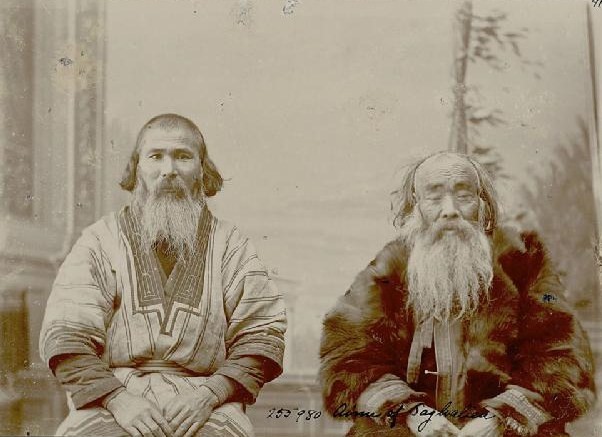 Sakhalin Ainu men, photographed by Bronisław Piłsudski |
 Kuril Ainu people within their traditional dwelling, 1903 |
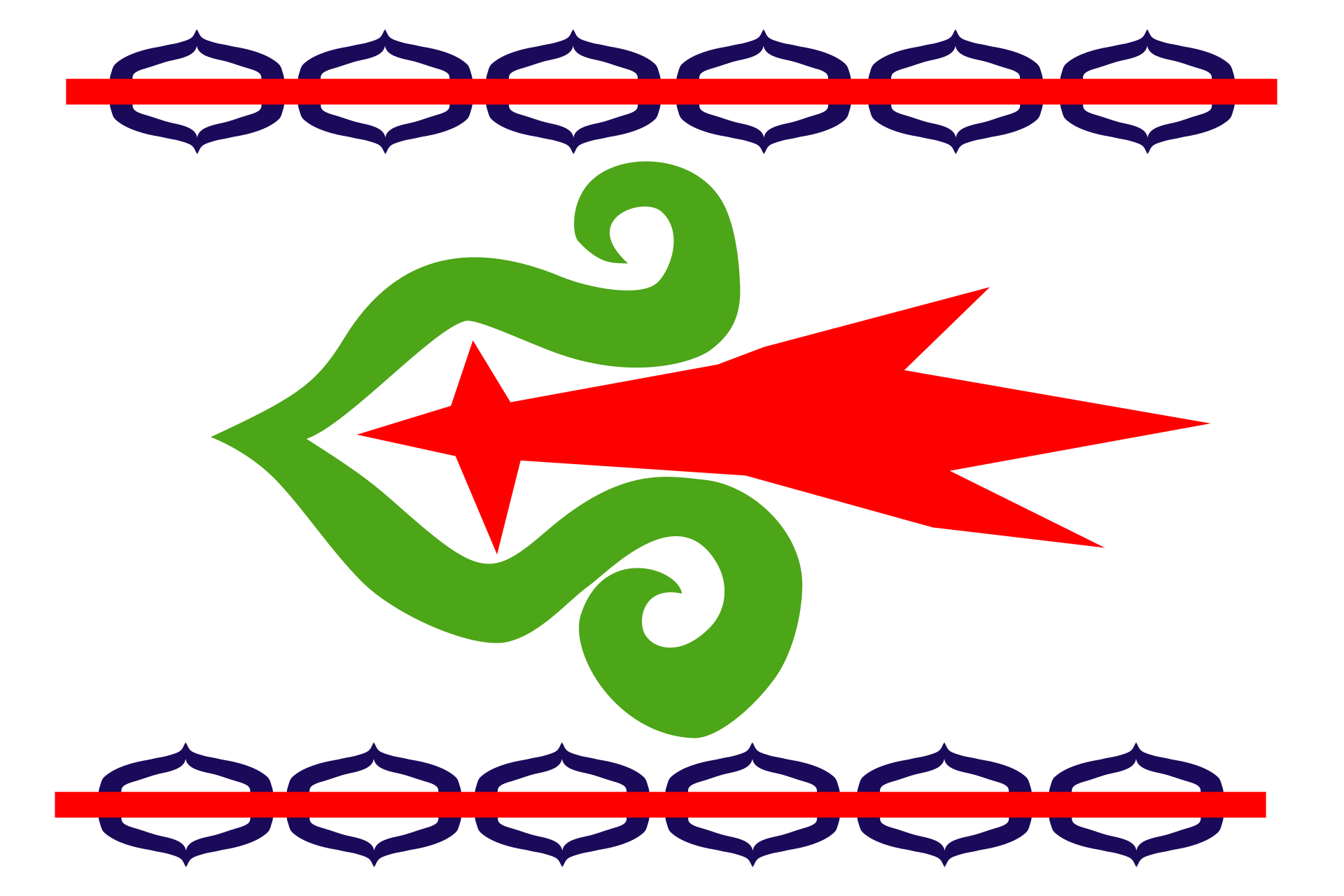 Flag of Sakhalin and Kuril Ainu. |
リ ンク
文 献
そ の他の情報
Copyleft, CC, Mitzub'ixi Quq Chi'j, 1996-2099
☆
 ☆
☆